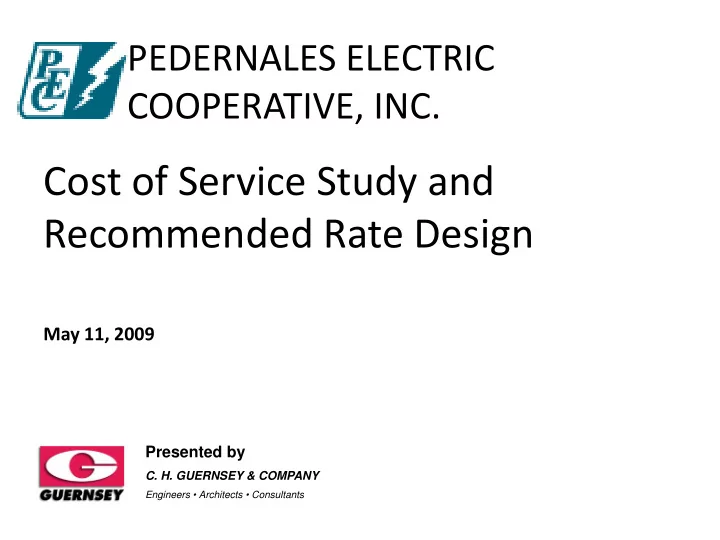

PEDERNALES ELECTRIC COOPERATIVE, INC. Cost of Service Study and Recommended Rate Design May 11, 2009 Presented by C. H. GUERNSEY & COMPANY Engineers • Architects • Consultants
Cost of Service and Rate Design Study Objectives: • Ensure members are charged fair rates • Ensure PEC reaches financial objectives • Ensure non-discriminatory approach for all members • Balance needs of PEC with impact on members • Better align PEC with industry standards • Encourage energy efficiency • The ability to react to changes in power cost 2
Cost of Service and Rate Design Study Review: • Use standard industry and regulatory practices • Select a test year and make adjustments that are “known, measurable and continuing in nature” • Prepare a financial forecast to determine the revenue requirement • Develop a cost of service study, allocating the adjusted cooperative expenses to the rate classes as those expenses are incurred • Design rates • Develop a line extension policy based on allowable investment aligned with rate design 3
Cost of Service and Rate Design Study How costs are incurred: PEC builds facilities & provides service based on: • Serving each meter no matter how small or how large • Building facilities to serve the peak load PEC purchases power and passes through to members its power cost based on: • The cost of power is determined by the wholesale supplier’s rate 4
Cost of Service and Rate Design Study PEC specific considerations: • Ability to grow equity, reflecting changes in the reporting of contributed capital • Incorporation of forecast for “low” growth • Ability to pay capital credits • Establishment of new guidelines for proper implementation of power cost recovery • Line extension policy review 5
Cost of Service and Rate Design Study Key Findings: • Since last rate study, PEC expenses have increased significantly driven by area growth and inflation • Current PEC establishment fee and line extension policies are not industry standard • Current PEC service availability charge is significantly lower than needed to recover fixed costs • The PCRF (power cost recovery factor) is not clearly or directly tied to power costs • Service availability cost for Large Power members does not sufficiently consider load factor, efficiency and load size 6
Revenue Requirement Adjusted Test Year – Proposed Rates Margin 7% Fixed 16% Non-Labor 8% Labor Power Cost 10% 59% Note: Percentages within cooperative electric industry norms 7
Billing Change • Existing rates and Original Proposed rates – Rates included both the PEC Delivery Charge and Power cost with four alternate rate designs • First Revision – Power cost and PEC Delivery Charges separated with two alternate rate designs • Recommended – PEC charges, base power cost and power cost adjustment separated into pieces to allow the member to clearly identify how much of the bill is: 1) Service Availability Charge 2) Distribution Energy Charge 3) Base Power Cost at the time rates were established and 4) Power Cost Adjustment (changes in power cost relative to base power cost) 8
9
How the Power Cost will work: • Base power cost is $0.072077 per kWh for secondary customers – this is fixed until the board authorizes the next general rate change Power Cost Adjustment: • LCRA is lowering the wholesale rate which will be reflected on PEC’s July 2009 LCRA Bill • Base power cost will remain $0.072077 per kWh for secondary customers. • The reduction in the wholesale rate will flow through to members directly through the Power Cost Adjustment 10
11
12
13
Every kWh the member conserves, lowers his or her bill by $0.104201 PEC gets a reduction of $0.032124 in reduced delivery revenue PEC’s delivery costs do not go down Every kWh the member conserves, lowers PEC’s margins by $0.032124 14
PURPA • PURPA requires the cooperative to consider rate designs that encourage energy efficiency. • It also requires the cooperative to consider that it “remove the throughput incentive and other regulatory and management disincentives to energy efficiency.” • PEC is committed to promoting conservation and energy efficiency. • Recovering distribution wires costs through energy charges is a disincentive to the cooperative to promote energy efficiency. 15
16
17
18
Note : Recommended billing includes Base Power Cost of $0.072077 per kWh. The Power Cost Adjustment factor will also be applicable to lighting 19
Line Extension Policy • Proposed procedure – Adjust Establishment Fee and add Line Extension policy providing for Contribution in Aid of Construction (CIAC) – Proposed Accounting: CIAC reduces capital costs (depreciation and interest) which, over time, improves equity and lowers upward pressure on rates • Cost of Service Study determines allowable investment PEC can make to serve each rate class • Consistent with other Texas cooperatives 20
System Impact Fee / Contribution in Aid of Construction • Member pays System Impact Fee of $200 • PEC allows $2,000. For the typical residential customer this includes: – 1 span of overhead single phase primary line – The cost of a single phase transformer – Service line from the transformer to the meter – The meter • Member pays full cost in excess of $2,000 21
FUTURE CONSIDERATIONS • Time of Use (TOU) rates • Wind / Renewable rates • Distributed generation 22
Recommend
More recommend